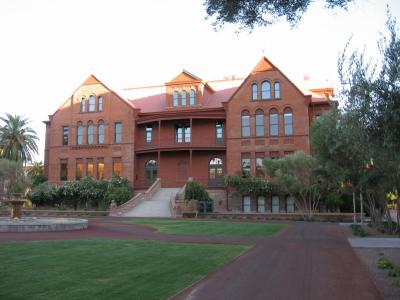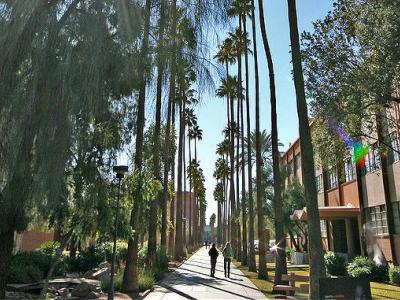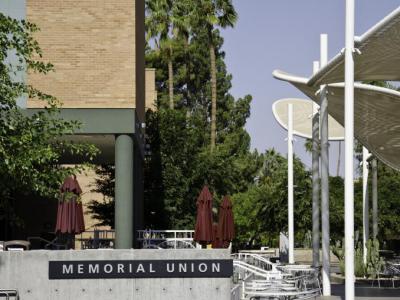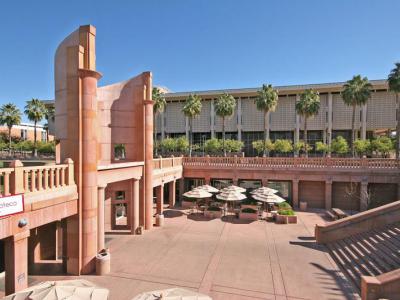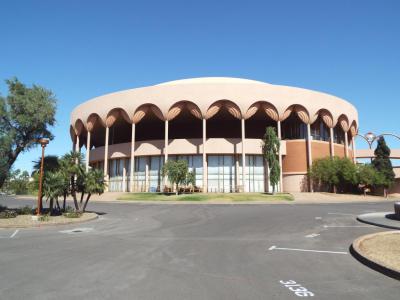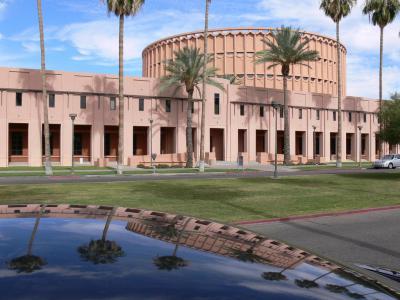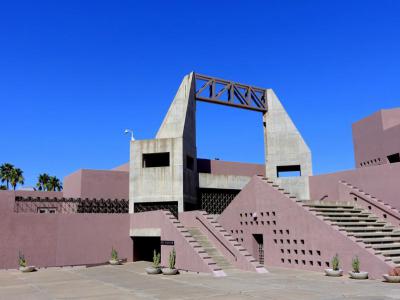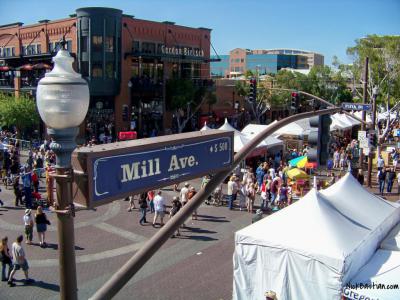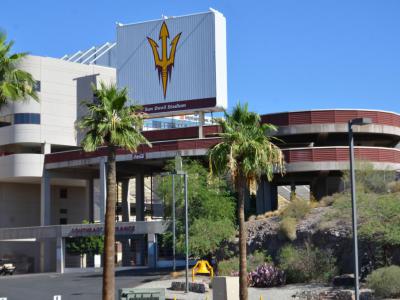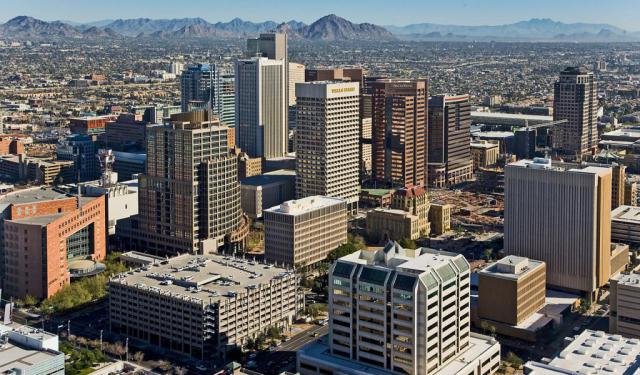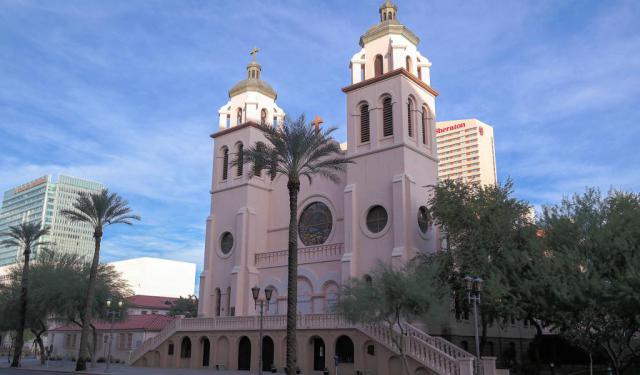Arizona State University (ASU) Walking Tour (Self Guided), Phoenix
Founded in 1885 by the 13th Arizona Territorial Legislature, Arizona State University (ASU) is one of the largest public universities by enrollment in the United States. ASU has nearly 150,000 students attending classes across its five campuses and four regional learning centers throughout the state.
The university's main campus at Tempe Arizona, east of downtown Phoenix, is an attraction in its own right, spread across nearly 66 acres of land.
At the heart of it, stands a historic landmark known as "Old Main," representing the university's beginnings and traditions.
Palm Walk, a picturesque pathway lined with palm trees, provides a scenic stroll through the campus and is a favorite spot for students to relax and take in the Arizona sunshine. The Sun Devil Fitness Complex offers state-of-the-art facilities for students to stay active and healthy.
The Student Pavilion is a hub of student life, hosting events, clubs, and organizations. The Memorial Union is another bustling center where students gather for dining, socializing, and various activities.
Hayden Library is a sanctuary for students seeking quiet study spaces and a vast collection of resources. Gammage Memorial Auditorium, designed by renowned architect Frank Lloyd Wright, is a sizable venue for concerts, performances, and lectures.
The Music Building and ASU Art Museum at Nelson Fine Arts Center nurture creativity and artistic expression, while Mill Avenue, adjacent to the campus, offers a vibrant nightlife and shopping experience.
Of course, one cannot forget Sun Devil Stadium, where the university's football team, the Sun Devils, battle it out on the field, creating an electrifying atmosphere for fans.
If you're considering your higher education path or simply looking for an excursion, ASU in Phoenix offers a diverse and dynamic environment with a blend of history, culture, and modernity. Visit ASU's campus to experience its unique charm and explore the countless opportunities it has to offer. Your educational and fun journey starts here and now!
The university's main campus at Tempe Arizona, east of downtown Phoenix, is an attraction in its own right, spread across nearly 66 acres of land.
At the heart of it, stands a historic landmark known as "Old Main," representing the university's beginnings and traditions.
Palm Walk, a picturesque pathway lined with palm trees, provides a scenic stroll through the campus and is a favorite spot for students to relax and take in the Arizona sunshine. The Sun Devil Fitness Complex offers state-of-the-art facilities for students to stay active and healthy.
The Student Pavilion is a hub of student life, hosting events, clubs, and organizations. The Memorial Union is another bustling center where students gather for dining, socializing, and various activities.
Hayden Library is a sanctuary for students seeking quiet study spaces and a vast collection of resources. Gammage Memorial Auditorium, designed by renowned architect Frank Lloyd Wright, is a sizable venue for concerts, performances, and lectures.
The Music Building and ASU Art Museum at Nelson Fine Arts Center nurture creativity and artistic expression, while Mill Avenue, adjacent to the campus, offers a vibrant nightlife and shopping experience.
Of course, one cannot forget Sun Devil Stadium, where the university's football team, the Sun Devils, battle it out on the field, creating an electrifying atmosphere for fans.
If you're considering your higher education path or simply looking for an excursion, ASU in Phoenix offers a diverse and dynamic environment with a blend of history, culture, and modernity. Visit ASU's campus to experience its unique charm and explore the countless opportunities it has to offer. Your educational and fun journey starts here and now!
How it works: Download the app "GPSmyCity: Walks in 1K+ Cities" from Apple App Store or Google Play Store to your mobile phone or tablet. The app turns your mobile device into a personal tour guide and its built-in GPS navigation functions guide you from one tour stop to next. The app works offline, so no data plan is needed when traveling abroad.
Arizona State University (ASU) Walking Tour Map
Guide Name: Arizona State University (ASU) Walking Tour
Guide Location: USA » Phoenix (See other walking tours in Phoenix)
Guide Type: Self-guided Walking Tour (Sightseeing)
# of Attractions: 11
Tour Duration: 2 Hour(s)
Travel Distance: 3.6 Km or 2.2 Miles
Author: DanaOffice
Sight(s) Featured in This Guide:
Guide Location: USA » Phoenix (See other walking tours in Phoenix)
Guide Type: Self-guided Walking Tour (Sightseeing)
# of Attractions: 11
Tour Duration: 2 Hour(s)
Travel Distance: 3.6 Km or 2.2 Miles
Author: DanaOffice
Sight(s) Featured in This Guide:
- Old Main
- Palm Walk
- Sun Devil Fitness Complex
- Student Pavilion
- Memorial Union
- Hayden Library
- Gammage Memorial Auditorium
- Music Building
- ASU Art Museum at Nelson Fine Arts Center
- Mill Avenue
- Sun Devil Stadium
1) Old Main
The Old Main is the oldest building on Arizona State University's campus in Tempe. This building was dedicated in 1898 and still cuts an impressive figure with its three stories. One of the firsts that this building boasts is being the first building in Tempe to feature electricity.
One of The Old Main's claims to fame was serving as the setting where Teddy Roosevelt gave his address when the dam that bears his name was dedicated. The house has been on the National Register of Historic Places since 1985. Restoration efforts during the 1990s helped restore this building to its original state.
Two Joseph M. Henninger murals dating back to the 1930s are on display. "Industrial Development in Arizona" offers a look at how this state grew through technology, and "Spanish Influence in Arizona" provides insights into the impact of Spanish culture. Both of these murals are impressive displays worthy of your time.
One of The Old Main's claims to fame was serving as the setting where Teddy Roosevelt gave his address when the dam that bears his name was dedicated. The house has been on the National Register of Historic Places since 1985. Restoration efforts during the 1990s helped restore this building to its original state.
Two Joseph M. Henninger murals dating back to the 1930s are on display. "Industrial Development in Arizona" offers a look at how this state grew through technology, and "Spanish Influence in Arizona" provides insights into the impact of Spanish culture. Both of these murals are impressive displays worthy of your time.
2) Palm Walk
The Palm Walk is a pedestrian mall located on Arizona State University's Tempe campus that is lined with one hundred and five Mexican fan palms. Running from the foot of the University bridge to the north, to the Student Recreation Complex to the south, the path runs for almost four-tenths of a mile. The path itself follows the old alignment of Normal Avenue, before it was incorporated into the expanding college's campus.
The history of the palm walk dates to an early attempt at campus beautification by Tempe Normal School President Arthur John Matthews. The best estimates for when the trees were planted vary from 1916 to 1919, although there also exist orders for trees in 1917 and 1918, the latter of which mentions the purchase of palm trees. Originally planted on the northern end of the walk near the original Normal School campus, the trees were later planted to the south, as the college expanded.
As the Palm Walk runs along the former alignment of Normal Avenue to what would have been the eastern edge of the main campus as it was built, it marked the eastern boundary for campus. As the college expanded over the years, it has become a local landmark for the university. The University Archives maintains a Web site that displays photos of Palm Walk from the 1930s, 1946, 1957, 1966, and the 1990s.
Originally, there was no official name for the Palm Walk, as a 1926 catalog for the school called it College Palms. By 1932, the name was simplified and called The Palms, and the earliest known use of the current name was from a 1967 pamphlet that used palm walk.
The history of the palm walk dates to an early attempt at campus beautification by Tempe Normal School President Arthur John Matthews. The best estimates for when the trees were planted vary from 1916 to 1919, although there also exist orders for trees in 1917 and 1918, the latter of which mentions the purchase of palm trees. Originally planted on the northern end of the walk near the original Normal School campus, the trees were later planted to the south, as the college expanded.
As the Palm Walk runs along the former alignment of Normal Avenue to what would have been the eastern edge of the main campus as it was built, it marked the eastern boundary for campus. As the college expanded over the years, it has become a local landmark for the university. The University Archives maintains a Web site that displays photos of Palm Walk from the 1930s, 1946, 1957, 1966, and the 1990s.
Originally, there was no official name for the Palm Walk, as a 1926 catalog for the school called it College Palms. By 1932, the name was simplified and called The Palms, and the earliest known use of the current name was from a 1967 pamphlet that used palm walk.
Sight description based on Wikipedia.
3) Sun Devil Fitness Complex
Sun Devil Fitness Complex is on the Arizona State University campus. This facility is where intramural, recreational, and fitness activities on campus take place. A couple of the things that users enjoy the most about this complex include access to exercise machines and free weights. Visitors with injuries or disabilities have access to adaptive equipment as well.
One of the highlights of this complex is the swimming pool, which visitors are welcome to access all year. This pool is one of the longest collegiate pools in the U.S. Anyone who wants to swim a few laps or more will be very satisfied with this pool.
Anyone visiting the complex will want to check out The Student Recreation Complex Fields. Both fields are lighted, and there is a running track bordering the whole perimeter of the fields. Some of the sports you may have the opportunity to watch include basketball, flag football, and softball.
One of the highlights of this complex is the swimming pool, which visitors are welcome to access all year. This pool is one of the longest collegiate pools in the U.S. Anyone who wants to swim a few laps or more will be very satisfied with this pool.
Anyone visiting the complex will want to check out The Student Recreation Complex Fields. Both fields are lighted, and there is a running track bordering the whole perimeter of the fields. Some of the sports you may have the opportunity to watch include basketball, flag football, and softball.
4) Student Pavilion
The Student Pavilion at ASU in Tempe hosts student productions and guest lectures, comedy acts, and concerts. One of the best things about this venue is its versatility, allowing a wide variety of acts to perform, with seating for up to 1,200. Visitors who choose to see the acts that perform at this location are certain to enjoy the experience.
Because the Pavillion can also function as three smaller event spaces, this building offers an ideal setting for conferences and similar events. Anyone touring the campus will want to stay updated on any events that are going on, so you don't miss anything.
One thing that stands out about this venue is its net-zero energy design. The ultimate goal as part of this initiative as to have the building produce as much energy as it consumes. You'll appreciate the effort that has gone into this initiative.
Because the Pavillion can also function as three smaller event spaces, this building offers an ideal setting for conferences and similar events. Anyone touring the campus will want to stay updated on any events that are going on, so you don't miss anything.
One thing that stands out about this venue is its net-zero energy design. The ultimate goal as part of this initiative as to have the building produce as much energy as it consumes. You'll appreciate the effort that has gone into this initiative.
5) Memorial Union
Memorial Union is often described as Arizona State University's "living room", a community center on campus since 1956. Regardless of whether gathering for a planned event or simply hanging out, anyone who goes into this building will enjoy a comfortable experience. There are several places where visitors can get something to eat, purchase things they need or take time for relaxation and reflection.
Some of the dining options include quick-serve favorites such as Burger King, Subway, and Starbucks. Visitors looking for hairstyling services will find them at Hair Logix, which specializes in eco-friendly products. An information desk allows visitors to find everything they are looking for easily.
The Memorial Union building has an Interfaith Reflection Room, ideal for prayer, meditation, and reflection for people of all faiths. The Veteran Memorial Wall commemorates the lives of fallen military members who have attended ASU, including Pat Tillman. This memorial is on the lowest level of the building, near the Pat Tillman Veterans Center.
Pat Tillman was a NFL player who left his professional sports career to be enlisted in the United States Army. He served in Iraq and Afghanistan before his death. Tillman attended ASU during 1996-1998.
Some of the dining options include quick-serve favorites such as Burger King, Subway, and Starbucks. Visitors looking for hairstyling services will find them at Hair Logix, which specializes in eco-friendly products. An information desk allows visitors to find everything they are looking for easily.
The Memorial Union building has an Interfaith Reflection Room, ideal for prayer, meditation, and reflection for people of all faiths. The Veteran Memorial Wall commemorates the lives of fallen military members who have attended ASU, including Pat Tillman. This memorial is on the lowest level of the building, near the Pat Tillman Veterans Center.
Pat Tillman was a NFL player who left his professional sports career to be enlisted in the United States Army. He served in Iraq and Afghanistan before his death. Tillman attended ASU during 1996-1998.
6) Hayden Library
The Hayden Library is Arizona State University's biggest ahd the most visited library on campus. This building was constructed in 1966 and has seen renovations that have helped make it a state-of-the-art facility. The five-story tower features a contemporary design that helps highlight the open space available in the building.
Expanded study areas and two reading rooms help provide quieter spaces for enjoying your books. Interdisciplinary labs and research services help set the library apart as a center of learning. One floor of the library has been dedicated to innovation, helping to show the school's contributions to modern science.
There is a golden staircase that serves as a bit of Sun Devil pride, as well as a mural that depicts the local Native American cultures. The floor-to-ceiling windows let in a lot of light, reducing the dependence on artificial light. A bonus that these windows offer is impressive views of the campus.
Expanded study areas and two reading rooms help provide quieter spaces for enjoying your books. Interdisciplinary labs and research services help set the library apart as a center of learning. One floor of the library has been dedicated to innovation, helping to show the school's contributions to modern science.
There is a golden staircase that serves as a bit of Sun Devil pride, as well as a mural that depicts the local Native American cultures. The floor-to-ceiling windows let in a lot of light, reducing the dependence on artificial light. A bonus that these windows offer is impressive views of the campus.
7) Gammage Memorial Auditorium
The Gammage Memorial Auditorium is on the Arizona State University campus and named after Grady Grammage, the former ASU President. This auditorium was one of the last public works completed by noted architect Frank Lloyd Wright. The building is on the National Register of Historic Places and is one of the world's largest university performing arts venues.
This auditorium is one of the larger public structures on campus, measuring 300 feet in length, 250 feet in width, and 80 feet in height. There are 50 concrete columns that help support the roof, with an interlocking circle pattern. Pedestrian ramps that lead from the parking area have a flying buttress design.
One of the things that stands out the most about this auditorium is its versatility. The stage adapts for use for larger-scale productions like Broadway musicals, grand opera, and organ recitals. This space is also commonly used for smaller productions, solo performances, and lectures.
This auditorium is one of the larger public structures on campus, measuring 300 feet in length, 250 feet in width, and 80 feet in height. There are 50 concrete columns that help support the roof, with an interlocking circle pattern. Pedestrian ramps that lead from the parking area have a flying buttress design.
One of the things that stands out the most about this auditorium is its versatility. The stage adapts for use for larger-scale productions like Broadway musicals, grand opera, and organ recitals. This space is also commonly used for smaller productions, solo performances, and lectures.
8) Music Building
The Music Building at Arizona State University hosts the Arizona School of Music. This building, of 1970 construction, has eight levels and features a design described as being similar to a birthday cake. The Music Building is next to the Grammage Auditorium and was designed by Frank Lloyd Wright's son-in-law, Wesley Peters.
One of the highlights of this building is a Fritts organ, with 1,800 hand-carved pipes. The Evelyn Smith Music Theater is in this building, as well as the Music Research Facility. There are also practice and recital rooms available for student use.
Another key highlight of this building is the Rafael Mendez Library, highlighting this composer, performer, and teacher. Photos and album covers, along with concert programs, provide a look into Mendez's life as a performer. Additional items that make up the collections include correspondence, news clippings, and the original manuscripts from Mendez's compositions.
One of the highlights of this building is a Fritts organ, with 1,800 hand-carved pipes. The Evelyn Smith Music Theater is in this building, as well as the Music Research Facility. There are also practice and recital rooms available for student use.
Another key highlight of this building is the Rafael Mendez Library, highlighting this composer, performer, and teacher. Photos and album covers, along with concert programs, provide a look into Mendez's life as a performer. Additional items that make up the collections include correspondence, news clippings, and the original manuscripts from Mendez's compositions.
9) ASU Art Museum at Nelson Fine Arts Center
The Arizona State University Art Museum is an art museum operated by Arizona State University, located on its main campus in Tempe, Arizona. The Art Museum has some 12,000 objects in its permanent collection and describes its primary focuses as contemporary art, including new media and "innovative methods of presentation"; crafts, with an emphasis on American ceramics; historic and contemporary prints; art from Arizona and the Southwestern United States, with an emphasis on Latino artists, and art of the Americas, with one historic American pieces and modernist and contemporary Latin American works.
The focus of ASU Art Museum's Latin American art holdings is on Mexican art from the 20th century, Mexican ceramics and folk art; and contemporary Cuban art. The core of the Latin American collection was donated to the museum in 1950 and includes works by David Alfaro Siqueiros, Diego Rivera, and Rufino Tamayo. Later acquisitions of pieces by Mexican artists include works by Carlos Mérida, Leonel Góngora, Rafael and Pedro Coronel; José Guadalupe Posada, Leopoldo Mendez, and other members of the Taller de Gráfica Popular; and the contemporary artists Alejandro Colunga, Lucio Muniain, and Nestor Quiñones.
The art collection was established in 1950. The museum is located in two buildings. The main exhibition space is the Nelson Fine Arts Center, designed by architect Antoine Predock. A second museum facility, the Ceramics Research Center lies to the north, on 7th Street and Mill Ave in the Brickyard Engineering Building.
Admission to the museum is free.
The focus of ASU Art Museum's Latin American art holdings is on Mexican art from the 20th century, Mexican ceramics and folk art; and contemporary Cuban art. The core of the Latin American collection was donated to the museum in 1950 and includes works by David Alfaro Siqueiros, Diego Rivera, and Rufino Tamayo. Later acquisitions of pieces by Mexican artists include works by Carlos Mérida, Leonel Góngora, Rafael and Pedro Coronel; José Guadalupe Posada, Leopoldo Mendez, and other members of the Taller de Gráfica Popular; and the contemporary artists Alejandro Colunga, Lucio Muniain, and Nestor Quiñones.
The art collection was established in 1950. The museum is located in two buildings. The main exhibition space is the Nelson Fine Arts Center, designed by architect Antoine Predock. A second museum facility, the Ceramics Research Center lies to the north, on 7th Street and Mill Ave in the Brickyard Engineering Building.
Admission to the museum is free.
Sight description based on Wikipedia.
10) Mill Avenue
Mill Avenue in Tempe is one of the most popular districts in the downtown area. Shopping, dining, and nightlife are some of the most popular reasons that visitors head to this area. One of the things that visitors can do as they tour this district is rent an e-bike. These bikes make it easier for visitors to see more that is available in this district.
For a friendly Irish pub setting, consider stopping by Rula Bula. You can also try a variety of American cuisine at Culinary Dropout. If you enjoy microbrewery experiences, try Pedal Haus Brewery, which also has American cuisine worth trying.
This district also offers a wealth of nightlife options for all tastes. The Low Key Piano Bar is one of the city's most popular places for a more intimate experience. Fat Tuesday has a lively party setting that will easily make you think of Mardi Gras when you drop in.
For a friendly Irish pub setting, consider stopping by Rula Bula. You can also try a variety of American cuisine at Culinary Dropout. If you enjoy microbrewery experiences, try Pedal Haus Brewery, which also has American cuisine worth trying.
This district also offers a wealth of nightlife options for all tastes. The Low Key Piano Bar is one of the city's most popular places for a more intimate experience. Fat Tuesday has a lively party setting that will easily make you think of Mardi Gras when you drop in.
11) Sun Devil Stadium
Sun Devil Stadium is an outdoor football stadium on the campus of Arizona State University in Tempe, Arizona. It is home to the Arizona State Sun Devils football team of the Pac-12 Conference. The stadium's seating capacity as of 2018 is 53,599, reduced from a peak of 74,865 in 1989. The natural grass playing surface within the stadium was named Frank Kush Field in 1996 in honor of the former coach of the Sun Devil football team.
The stadium has hosted two annual college football bowl games: the Fiesta Bowl from 1971 to 2006, and the Cactus Bowl from 2006 to 2015. Sun Devil Stadium was also home to the Arizona Cardinals of the National Football League (NFL) from 1988 through the 2005 season. Following the 2005 season, the Cardinals moved to State Farm Stadium.
Sun Devil Stadium has been the setting for several movies over the years. Some of them include Cameron Crowe's 1996 blockbuster film Jerry Maguire, U2's 1988 rockumentary Rattle and Hum, The Rolling Stones' 1982 concert film Let's Spend the Night Together, 1976's A Star is Born, with Barbra Streisand and Kris Kristofferson, the Coen Brothers' 1987 film Raising Arizona, and the 1980 film Used Cars. In 2003, the stadium was also featured on the finale episode of The Amazing Race 4, and in 2009 The U in ESPN's 30 for 30.
Pope John Paul II visited Phoenix on September 14, 1987, as a part of his whirlwind tour of the United States. In Tempe, he held Mass for 75,000 at Sun Devil Stadium.
The stadium has hosted two annual college football bowl games: the Fiesta Bowl from 1971 to 2006, and the Cactus Bowl from 2006 to 2015. Sun Devil Stadium was also home to the Arizona Cardinals of the National Football League (NFL) from 1988 through the 2005 season. Following the 2005 season, the Cardinals moved to State Farm Stadium.
Sun Devil Stadium has been the setting for several movies over the years. Some of them include Cameron Crowe's 1996 blockbuster film Jerry Maguire, U2's 1988 rockumentary Rattle and Hum, The Rolling Stones' 1982 concert film Let's Spend the Night Together, 1976's A Star is Born, with Barbra Streisand and Kris Kristofferson, the Coen Brothers' 1987 film Raising Arizona, and the 1980 film Used Cars. In 2003, the stadium was also featured on the finale episode of The Amazing Race 4, and in 2009 The U in ESPN's 30 for 30.
Pope John Paul II visited Phoenix on September 14, 1987, as a part of his whirlwind tour of the United States. In Tempe, he held Mass for 75,000 at Sun Devil Stadium.
Sight description based on Wikipedia.
Walking Tours in Phoenix, Arizona
Create Your Own Walk in Phoenix
Creating your own self-guided walk in Phoenix is easy and fun. Choose the city attractions that you want to see and a walk route map will be created just for you. You can even set your hotel as the start point of the walk.
Phoenix Introduction Walking Tour
Phoenix is the largest city in Arizona and the central city in a larger metropolitan area known as the Valley of the Sun. The city was first settled as an agricultural community where the Salt and Gila Rivers met. An intricate canal system keeps this hot corner of the Sonoran Desert fertile. In the early days, the city's economy was based on the "Five Cs"-citrus, cotton, copper,... view more
Tour Duration: 2 Hour(s)
Travel Distance: 3.7 Km or 2.3 Miles
Tour Duration: 2 Hour(s)
Travel Distance: 3.7 Km or 2.3 Miles
Downtown Historical Landmarks Walking Tour
The downtown area of Phoenix, Arizona, is loaded with notable sites, each bearing witness to a unique chapter in the city's past, from the Victorian elegance of the Rosson House Museum to the spiritual grandeur of Saint Mary's Basilica and the cinematic allure of the Barrister Building.
The latter, known as "The Psycho" Building, gained fame for its cameo in Alfred... view more
Tour Duration: 2 Hour(s)
Travel Distance: 3.9 Km or 2.4 Miles
The latter, known as "The Psycho" Building, gained fame for its cameo in Alfred... view more
Tour Duration: 2 Hour(s)
Travel Distance: 3.9 Km or 2.4 Miles
The Most Popular Cities
/ view all



